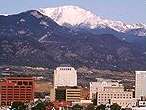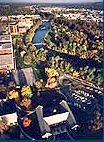|
Colorado Springs Fastest-Growing 'Cybercity'
Expansions Have Broadly Dispersed
U.S. Tech Clusters, AEA/Nasdaq Study Finds
By JACK LYNE • Site Selection Executive Editor of Interactive Publishing
The tech is as high as an elephant's eye far, far beyond Silicon Valley.
 While that fabled Northern California area remains the U.S. epicenter of high tech, the industry has broadly dispersed; 33 U.S. states are now home to at least one "cybercity," and seven states have at least three. The fastest-growing cybercity? Colorado Springs, Colo., followed by San Francisco, Houston, Denver and Sacramento, Calif. While that fabled Northern California area remains the U.S. epicenter of high tech, the industry has broadly dispersed; 33 U.S. states are now home to at least one "cybercity," and seven states have at least three. The fastest-growing cybercity? Colorado Springs, Colo., followed by San Francisco, Houston, Denver and Sacramento, Calif.
So says "Cybercities: A City-by-City Overview of the High-Technology Industry," recently released by the American Electronic Assn. (AEA at www.aeanet.org) and Nasdaq (www.nasdaq.com). Spanning a 1993-98 timeframe, the study documented the job-creation impact of broad-ranging high-tech expansion patterns.
San Jose, however, remained the No. 1 job source of U.S. high-tech jobs in the AEA/Nasdaq study.
ABOVE RIGHT: Rocky Mountain high tech: Colorado Springs was the metro with the fastest high-tech growth in the AEA/Nasdaq study. During 1993-98, the Colorado city's high-tech employment increased by 77 percent.
As of yearend 1998, the city had 252,900 tech jobs; high tech, in fact, accounted for one of every four existing jobs in the San Jose MSA.
Boston, however, was not far behind at No. 2, with 234,800 high-tech jobs, followed by Chicago, Washington, D.C., and Dallas. Boston, in fact, was the leader in the analysis through the end of 1996, AEA executives reported.
Timeframes and Caveats
The Cybercities study covered 60 U.S. metropolitan areas, selected "because they are the nation's leaders in high-tech employment . . . [with] at least 15,000 tech jobs," AEA President William Archey said in releasing the report.
A substantial caveat, however, accompanies the study:
It was based on two-year-old data from the U.S. Dept. of Labor.
That's a very long time in an industry as fast changing as high tech -- particularly in light of the recent dot.com nosedive that has significantly thinned the tech ranks.
Archey, however, said 2000 data may not be available until 2002.
Seattle's Average High-Tech Salary a Whopping $129,330
With those limitations in mind, here's a look at some of other findings from the Cybercities report:
- The top five metros' specific high-tech employment totals were San Jose with 252,900; Boston with 234,800; Chicago with 180,400; Washington, D.C., with 177,700; and Dallas with 176,600.
- The highest growth rates in high-tech jobs were recorded for Colorado Springs, Colo., with 77 percent growth; San Francisco with 65 percent; Houston with 64 percent; Denver with 63 percent, and Sacramento, Calif., with 57 percent.
- With an annual average salary of US$129,330, Seattle's high-tech workers were the highest paid, making more than three times the Washington metro's average private-sector wage.
- Seattle's salary levels were a whopping 52 percent higher than in San Jose, where the average annual high-tech salary of $85,100 ranked No. 2.
- San Jose, however, ranked as the leading U.S. cybercity in "computers, electronic components, semiconductors, and industrial electronics manufacturing."
- The U.S. high-tech industry added 1.1 million new jobs during 1993-98, 8 percent of the U.S. private sector's new jobs during that timeframe, said the study. Of the 60 analyzed cybercities, 59 added tech jobs during 1993-98, with Rochester, N.Y., the lone exception.
What Make a Cybercity?
The study also drew some (unsurprising) conclusions on "common traits [among] the nation's top cybercities." Those traits included:
- "A strong education system to create a pool of talented workers,"
- "An existing critical mass of like companies,"
- "A vibrant venture capital market that can allow companies to flourish and grow,"
- "A solid transportation infrastructure" and
- "A population that uses today's new technologies."
The more elusive concept of quality of life is also a major cybercity factor, according to the AEA/Nasdaq study.
 "For some it means a good climate, for others, a short commute or a vibrant arts and cultural environment," said Archey. "One of the fastest-growing cybercities is Boise, [Idaho]." Ranked No. 50 in total high-tech jobs, the Boise metro ranked ninth in high-tech concentration, which accounted for 11.2 percent of that metro's total private-sector employment. "For some it means a good climate, for others, a short commute or a vibrant arts and cultural environment," said Archey. "One of the fastest-growing cybercities is Boise, [Idaho]." Ranked No. 50 in total high-tech jobs, the Boise metro ranked ninth in high-tech concentration, which accounted for 11.2 percent of that metro's total private-sector employment.
RIGHT: Not-so-private Idaho: While the Boise River was once the area's lifeblood, Boise's high-tech concentration is now the ninth-largest, accounting for 11.2 percent of the metro's total private-sector employment.
The full Cybercities study is available through AEA for $95 for members or $190 for non-members.
LOOKING FOR MORE? BROWSE THE "SNAPSHOT FROM THE FIELD" ARCHIVE
sf0108sf0108
©2001 Conway Data, Inc. All rights reserved. Data is from many sources and is not warranted to be accurate or current.
|
 While that fabled Northern California area remains the U.S. epicenter of high tech, the industry has broadly dispersed; 33 U.S. states are now home to at least one "cybercity," and seven states have at least three. The fastest-growing cybercity? Colorado Springs, Colo., followed by San Francisco, Houston, Denver and Sacramento, Calif.
While that fabled Northern California area remains the U.S. epicenter of high tech, the industry has broadly dispersed; 33 U.S. states are now home to at least one "cybercity," and seven states have at least three. The fastest-growing cybercity? Colorado Springs, Colo., followed by San Francisco, Houston, Denver and Sacramento, Calif.
 "For some it means a good climate, for others, a short commute or a vibrant arts and cultural environment," said Archey. "One of the fastest-growing cybercities is Boise, [Idaho]." Ranked No. 50 in total high-tech jobs, the Boise metro ranked ninth in high-tech concentration, which accounted for 11.2 percent of that metro's total private-sector employment.
"For some it means a good climate, for others, a short commute or a vibrant arts and cultural environment," said Archey. "One of the fastest-growing cybercities is Boise, [Idaho]." Ranked No. 50 in total high-tech jobs, the Boise metro ranked ninth in high-tech concentration, which accounted for 11.2 percent of that metro's total private-sector employment.